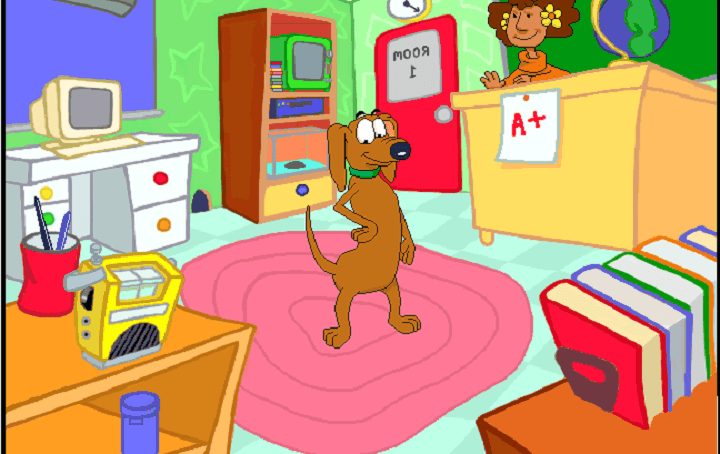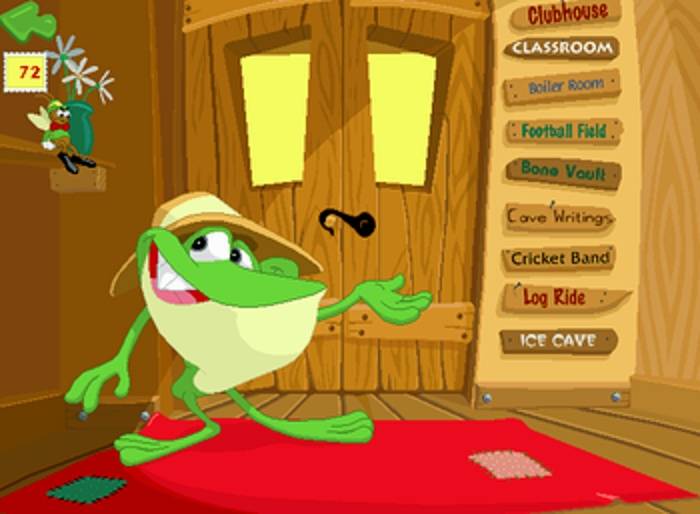JumpStart Game: The Computer Classroom That Made One Generation Love Learning

You turn on the family computer.
The screen flashes. A logo bounces.
Cheerful music. Talking animals. And then:
“Welcome to JumpStart!”
Suddenly, you’re flying with an eagle, crawling through pyramids, chasing math blimps, and solving spelling puzzles with a dog named Frankie.
You’re in school… but it doesn’t feel like school.
Welcome to JumpStart. The game turned homework into a treasure hunt. It has made math drills into boss fights. It turned vocabulary into an adventure.
Before Roblox, Minecraft Education Edition, Kahoot, there was JumpStart. It is a colorful, cartoon world. Which quietly taught kids when they thought they were playing.
This is the story of how one series of games revolutionized the meaning of “edutainment,” built a franchise of scores of games, educated a generation of online scholars, and continues to inspire nostalgia in tens of millions who grew up solving multiplication equations just to level up.
Strap in, class. We’re jumping back to the beginning.
What Is JumpStart?

JumpStart is a long-running series of educational games developed originally by Knowledge Adventure. The series debuted in the 1990s and became a defining staple of home computer learning.
Designed for kids from preschool through 6th grade, JumpStart offered interactive experiences that taught subjects like:
- Math
- Reading
- Writing
- Science
- Geography
- Critical thinking
Each game was in a fresh, child-friendly world full of characters, minigames, and stories, all revolving around grade-level curriculum standards.
It wasn’t learning, it was fun.
You didn’t do math problems, you went adventuring. You didn’t memorize spelling, you treated yourself to missions.
And due to its colorful characters, music, animation, and compelling game mechanics, children barely knew they were working on homework.
Why JumpStart Was a Game-Changer
It wasn’t edutainment’s first game. But it was the first that felt like a real game.
Here’s why it succeeded so well:
Age-Specific Design
Each game was created to a specific grade or age group. Which was from pre-preschoolers to preteens.
JumpStart Preschool for young children
JumpStart 1st Grade for reading, phonics, basic math
JumpStart 4th Grade for history, geography, and fractions
JumpStart Typing for typing skills
It wasn’t one-size-fits-all, it tailored itself to the player.
Rich Game Worlds
Each game was a virtual world. Which came with its own map, characters, and narrative.
You weren’t taking a quiz. You were exploring a haunted school there. By wandering on a tropical island, a flying factory, or a pirate ship.
Replay Value
JumpStart used progression, unlockables, and achievements to encourage replay.
You could:
- Unlock secret rooms
- Collect stars or coins
- Customize avatars
- Level up in mini-games
That’s an engaging design, especially with kids.
Voice Acting and Humor
From 3rd Grade’s snarky robots to disco dogs in JumpStart Typing, every character was unique.
This made kids engaged and emotionally attached, because Frankie the dog was a whole lot more interesting than a book.
A Timeline Through Time: The JumpStart Eras
Let’s break down the ages of JumpStart, because this franchise has had some significant evolution.
The CD-ROM Era (1994–2003)
The height, classics, and halcyon days.
These were solo PC games in big, brightly colored boxes at OfficeMax or Toys “R” Us.
Top-selling bestsellers:
- JumpStart Kindergarten (1994)
- JumpStart 2nd Grade (1996)
- JumpStart 5th Grade: Jo Hammet, Kid Detective (1999)
- JumpStart Advanced series (2000+)
These games were each an individual interactive Saturday morning cartoon.
The Online Universe Era (2007–2013)
As Flash games exploded and Neopets ran the browsers, JumpStart went online.
JumpStart World debuted as an MMO-style virtual world
Players had avatars, could chat, roam, and do story quests
It evolved into JumpStart.com, a subscription website with dozens of zones
This was JumpStart and World of Warcraft, albeit with multiplication tables.
And it was amazing.
The Mobile Shift (2010s)
JumpStart didn’t get left behind on the mobile wave.
Games such as:
- JumpStart Pet Rescue
- JumpStart Preschool Magic of Learning
- JumpStart Academy (with math, reading, and coding modules)
These apps made learning mobile and real.
Some became so popular, schools began recommending them to young students.
The Decline and Closure (2020s)
All good things have an end.
As technology progressed and new platforms were launched. Such as Prodigy, Khan Academy Kids, and ABCmouse. It lost market share.
By 2023, their site formally shut down its servers.
It was the end of an era. But the legacy lives on.
Fan Favorites and Beloved Games

By way of dozens of titles, a few were pure classics.
JumpStart 3rd Grade (1996)
Where you battle an outlaw robot named Polly from within a secret underground bunker.
Features:
- Geography, multiplication, vocabulary
- Time-based challenges
- Iconic: the math blimp and language lab
JumpStart Kindergarten (1994)
With “The Alphabet Song” and Mr. Hopsalot characters.
Features:
- Simple matching and counting
- Rewards with stars
- Computer control introduction
JumpStart Typing
Trained typing skills through rapid-fire arcade games.
Features:
- Blends speed with accuracy
- Sci-fi theme with cool sound design
JumpStart 5th Grade: Jo Hammet
A detective story with branching dialogue and mystery-solving.
It felt like an adventure game with a curriculum bonus.
JumpStart Artist
A hidden gem that taught drawing, perspective, color theory, and creativity.
A perfect example of learning beyond just academics.
Side Quest: Characters You’ll Never Forget

Every JumpStart game had its host, a guide, friend, or comic relief.
Frankie the Dog – mascot of the entire franchise
Edison the Firefly – your 1st Grade companion
Polly Spark – your 3rd Grade tech nemesis
Botley the Robot – your World helper
Ms. Winkle – the cheerful teacher in Kindergarten
These characters existed beyond mere NPCs, they were our teachers, buddies, and sometimes adversaries.
JumpStart at School vs JumpStart at Home
Many kids experienced JumpStart in classrooms both at school and at home.
At School:
- Used primarily on shared computers
- Sometimes installed in smartboards
Access controlled, sections assigned by teachers
At Home:
- Complete control to explore
- Kids opened all the doors
- Parents used it to “snuck” learning on weekends
It was a rare edutainment brand that earned both kids’ and parents’ praises.
What Made JumpStart So Successful?
Let’s talk about learning theory.
JumpStart was way ahead of its time. It applied fundamental educational psychology concepts such as:
- Intrinsic motivation – Kids played because it was fun, not because they were told to
- Scaffolded learning – Ideas built step by step
- Immediate feedback – Rewards given immediately
- Game loops – Repeating through game mechanics reinforced retention
- Multisensory design – Sound, sight, touch all engaged
It wasn’t learning, it was quality learning.
Community, Mods, and the Nostalgia Boom
Ten years ago, a new generation of YouTubers, streamers, and bloggers re-discovered JumpStart.
Content:
- Old favorite Let’s Plays
- Deep lore dives (yes, there is lore)
- Modding projects to improve graphics
- Fan-made servers for JumpStart World
- Articles and videos named “You Probably Played THIS Game As a Kid”
The nostalgia is strong. And growing.
Some fans are even making spiritual successors, trying to introduce the format to modern classrooms.
Modern Alternatives: What’s Replacing JumpStart?
Need a 2025 JumpStart equivalent for your children? Try these:
- Khan Academy Kids – Free, adaptive learning
- ABCmouse – Structured curriculum with gamified rewards
- Osmo – Combines physical play with tablet learning
- Prodigy Math – RPG-style gameplay to get math problems solved
- Adventure Academy – Built by the same individuals who created ABCmouse, the gaming sibling of JumpStart World
None are so close, but all have JumpStart’s template to thank.
Final Thoughts: The Long-term Legacy of JumpStart
JumpStart was more than a game.
It was a movement, a revolution in the way kids interacted with learning.
It turned:
- Multiplication into an adventure
- Typing into a space mission
- Grammar into a puzzle
- Geography into a quest
It taught kids how to use computers. How to solve problems. How to learn through doing.
And it did it decades before most schools caught up.
So here’s to the floppy disks, the CD-ROMs, the secret passages you couldn’t access until you finished your math exercises.
Here’s to the rabbit holes of fun that equated to real skills.
Here’s to JumpStart—
The game that didn’t merely teach…
…it JumpStarted a whole generation.




